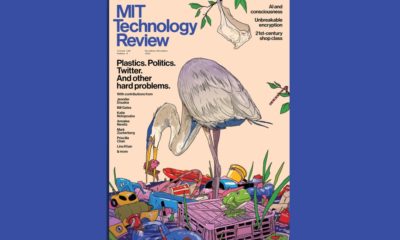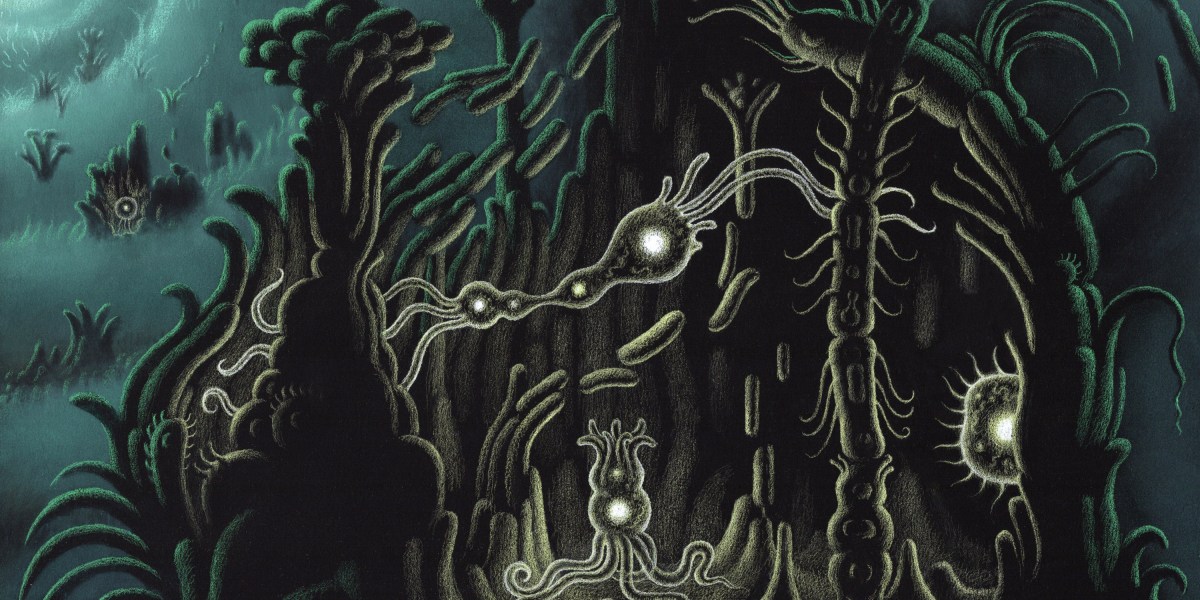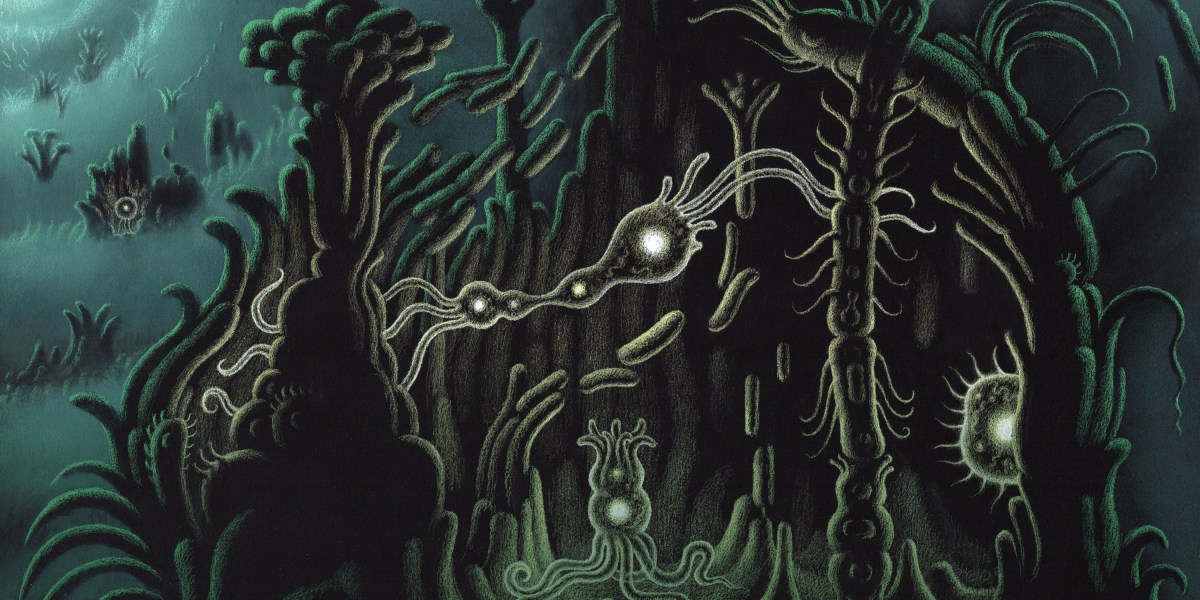Tech
The Biggest Questions: Are we alone in the universe?
Published
6 months agoon
By
Drew Simpson
In 1977, the New York Times published an article titled “Seeking an End to Cosmic Loneliness,” describing physicists’ attempts to pick up radio messages from aliens. The endeavor, known as the Search for Extraterrestrial Intelligence (SETI), was still in its early stages, and its proponents were struggling to persuade their peers and Congress that the idea was worth funding.
The quest to determine if anyone or anything is out there has gained greater scientific footing in the nearly half-century since that article’s publication. Back then, astronomers had yet to spot a single planet outside our solar system. Now we know the galaxy is teeming with a diversity of worlds. Our planet’s oceans were once considered exceptional, whereas evidence today suggests that numerous moons in the outer solar system host subsurface waters.
Our notion of the range of environments where life could exist has also expanded thanks to the discovery on Earth of extremophile organisms that can thrive in places far hotter, saltier, acidic, and more radioactive than previously thought possible, including creatures living around undersea hydrothermal vents.
We’re now getting closer than ever before to learning how common living worlds like ours actually are. New tools, including machine learning and artificial intelligence, could help scientists look past their preconceived notions of what constitutes life. Future instruments will sniff the atmospheres of distant planets and scan samples from our local solar system to see if they contain telltale chemicals in the right proportions for organisms to prosper.
“I think within our lifetime we will be able to do it,” says Ravi Kopparapu, a planetary scientist at NASA’s Goddard Space Flight Center in Maryland. “We will be able to know if there is life on other planets.”
While humans have a long history of speculating about distant worlds, for much of that time actual evidence was in short supply. The first planets around other stars—known as exoplanets—were discovered in the early 1990s, but it took until the launch of NASA’s Kepler space telescope in 2009 for astronomers to understand how common they were. Kepler carefully monitored hundreds of thousands of stars, looking for tiny dips in their brightness that could indicate planets passing in front of them. The mission helped the number of known exoplanets rise from a mere handful to over 5,500.
Kepler was built to help determine the prevalence of Earth-like planets orbiting sun-like stars at the right distance to have liquid water on their surface (a region often nicknamed the Goldilocks zone). While not a single extraterrestrial world has been a perfect twin of our own so far, researchers can use the sheer quantity of discoveries to make educated guesses as to how many might be out there. The current best estimates suggest that anywhere between 10% and 50% of sun-like stars have planets like ours, leading to numbers that make astronomers’ heads swim.
“If it’s 50%, that’s bonkers, right?” says Jessie Christiansen, an astrophysicist at Caltech in Pasadena, California. “There are billions of sun-like stars in the galaxy, and if half of them have Earth-like planets, there could be billions of habitable rocky planets.”
Is there anybody home?
Determining whether these planets actually contain organisms is no easy task. Researchers must capture the faint light from an exoplanet and spread it into its constituent wavelengths, scanning for signatures that indicate the presence and amount of different types of chemicals. While astronomers would like to focus on sun-like stars, doing so is technically challenging. NASA’s mighty new James Webb Space Telescope (JWST) is currently training its 6.5-meter mirror and unparalleled infrared instruments on worlds around stars smaller, cooler, and redder than our sun, known as M dwarfs. Such places might be habitable, but at the moment, nobody is really sure.
For liquid water to be present on their surfaces, planets around M dwarfs would need to orbit close to their stars—which tend to be more active than the sun, sending out violent flares that could strip away atmospheric gases and likely leave the ground a dry husk. JWST has been investigating Trappist-1, an M dwarf 40 light-years away with seven small rocky worlds, four of which are at the right distance to potentially have liquid water. The two closest exoplanets have already been shown to be devoid of atmospheres, but scientists are eagerly awaiting the results of JWST observations from the next three. They want to know if even those outside the habitable zone can have atmospheres.
There’s special interest in looking for other planets around M dwarf stars, because they are far more prevalent than sun-size stars. “If they find them to hold atmospheres, that increases the habitable real estate of the galaxy a hundredfold,” says Christiansen.
Once we’ve found a planet that looks a lot like Earth, then we’ll want to start hunting for chemical clues of life on its surface. JWST isn’t sensitive enough to do that, but future ground-based instruments like the Extremely Large Telescope, Giant Magellan Telescope, and Thirty Meter Telescope—which are expected to begin taking data in the 2030s—could tease out the chemical components of nearby Earth-like worlds. Information from more distant targets will have to wait for NASA’s next planned flagship mission, the space-based Habitable Worlds Observatory, expected to launch sometime in the late 2030s or early 2040s. The telescope will use either an external star shade or an instrument called a coronagraph to block the glaring light of a star and home in on dimmer planetary light and its potential molecular fingerprints.
Which chemicals in particular astronomers should be looking for remains a matter of debate. Ideally, they want to find what are known as biosignatures—molecules like water, methane, and carbon dioxide present in amounts similar to what we find on Earth. What that means in practice isn’t always clear, since our planet has gone through many periods when it contained life yet the quantities of different chemicals varied wildly.
“Do you want it to detect an Archaean Earth, like 2 or 3 billion years ago?” asks Kopparapu. “Or from the Neoproterozoic, where there was a snowball Earth? Or do you want to detect the current Earth, where there is a lot of free oxygen, ozone, water, and CO2?”
There was much excitement recently when JWST spotted dimethyl sulfide, a molecule that on our world is made only by living things, on an exoplanet nearly nine times Earth’s size located 120 light-years away. The results which have yet to be confirmed, highlight the trickiness of such methods. If dimethyl sulfide is truly present in the planet’s atmosphere, then starlight should also break it down to form ethane, a molecule that has yet to be seen. “No single gas is a biosignature,” says Kopparapu. “You need to see a combination of them.” Last year, he and others in the community published a report emphasizing that any particular finding must be placed in the context of its stellar and planetary environment, since there could be many results that seemingly point to life yet have alternative explanations.
Why counts as life?
This problem—how to definitively differentiate between life and non-life—is a perennial one, whether you’re looking at distant planets or even phenomena here on Earth. Researchers may soon receive help from algorithmic techniques that can tease out associations too complex for the human brain to fathom. In recent experiments, Robert Hazen and his colleagues took 134 living and non-living samples (including petroleum, carbon-rich meteorites, ancient fossils, and a wasp that flew into their lab), vaporized them, and spread out their chemical constituents. Roughly 500,000 different attributes were identified within each sample’s molecular makeup and run through a machine-learning program.
“When we look at those 500,000 attributes, there are patterns that are unique to living things and patterns unique to non-living things,” says Hazen, a mineralogist and astrobiologist at the Carnegie Institution for Science.
After the software was trained on 70% of the specimens, the technique was able to recognize with 90% accuracy which of the remaining samples had a biological origin. The device that is used to spread out the chemical components of the samples is around seven inches long, small enough to be sent on missions to nearby ocean worlds like Jupiter’s Europa or Saturn’s Enceladus. NASA’s Perseverance rover carried a similar instrument to Mars, so Hazen thinks his team’s machine-learning algorithm could be adapted to sift through its data and hunt for organisms past or present there. And because it relies on molecular relationships rather than detecting specific organic chemicals like DNA or amino acids, which may not be used in other biospheres, the method could allow scientists to look for life entirely unlike what we have on Earth.
Such machine-learning applications are also starting to find use in SETI, which has in recent years pivoted toward looking for a broader array of visible evidence for tool-using extraterrestrial species than before. Most in the field are on the lookout for such technosignatures, defined as “some remotely detectable signature of technology that we can characterize with astronomical instrumentation,” says Sofia Sheikh of the SETI Institute. This could be a radio signal, but other evidence could include things like optical laser pulses, giant space-based engineering projects, atmospheric pollution, or even artificial probes that make their way to our solar system.
At the Zwicky Transient Facility near San Diego, California, which continuously searches the entire night sky for brief flashes of light coming from unknown sources, engineers are teaching artificial intelligence how to identify features that would not be expected from natural phenomena. “It’s at that point that we can start asking questions,” says Ashish Mahabal, an astronomer and data scientist at Caltech. The answers to such questions could help reveal novel astronomical events or, just maybe, a star surrounded by enormous solar panels that feed an energy-intensive alien society.
SETI researchers hope that by using such tools, they can help overcome some of their anthropocentric biases. Most recognize that our expectations of otherworldly beings are constrained by our own experience. For example, the search for signs of massive alien solar panels is often “based on this assumption that there’s always going to be an exponential need for energy,” says Sheikh.
Because of all the avenues currently being explored, many scientists believe that answers to our questions about extraterrestrial life are not far off. Yet ultimately, the question of our cosmic loneliness is a philosophical one.
For most of humanity’s history, we didn’t believe ourselves to be alone. We filled the heavens with gods, monsters, and mythic creatures. It is only in the modern age that our species has started to worry about its place in the universe. But whether or not any other part of it harbors life, the cosmos is our home. We can choose to be lonely or to embrace the beauty and wonder all around us.
You may like
-


The Biggest Questions: What is death?
-


The Biggest Questions: Why is the universe so complex and beautiful?
-


The Download: defining AGI, and making sense of the complicated universe
-


The Biggest Questions: Is it possible to really understand someone else’s mind?
-


The Biggest Questions: How did life begin?
-


Tackling our biggest problems
Tech
The hunter-gatherer groups at the heart of a microbiome gold rush
Published
4 months agoon
12/19/2023By
Drew Simpson
The first step to finding out is to catalogue what microbes we might have lost. To get as close to ancient microbiomes as possible, microbiologists have begun studying multiple Indigenous groups. Two have received the most attention: the Yanomami of the Amazon rainforest and the Hadza, in northern Tanzania.
Researchers have made some startling discoveries already. A study by Sonnenburg and his colleagues, published in July, found that the gut microbiomes of the Hadza appear to include bugs that aren’t seen elsewhere—around 20% of the microbe genomes identified had not been recorded in a global catalogue of over 200,000 such genomes. The researchers found 8.4 million protein families in the guts of the 167 Hadza people they studied. Over half of them had not previously been identified in the human gut.
Plenty of other studies published in the last decade or so have helped build a picture of how the diets and lifestyles of hunter-gatherer societies influence the microbiome, and scientists have speculated on what this means for those living in more industrialized societies. But these revelations have come at a price.
A changing way of life
The Hadza people hunt wild animals and forage for fruit and honey. “We still live the ancient way of life, with arrows and old knives,” says Mangola, who works with the Olanakwe Community Fund to support education and economic projects for the Hadza. Hunters seek out food in the bush, which might include baboons, vervet monkeys, guinea fowl, kudu, porcupines, or dik-dik. Gatherers collect fruits, vegetables, and honey.
Mangola, who has met with multiple scientists over the years and participated in many research projects, has witnessed firsthand the impact of such research on his community. Much of it has been positive. But not all researchers act thoughtfully and ethically, he says, and some have exploited or harmed the community.
One enduring problem, says Mangola, is that scientists have tended to come and study the Hadza without properly explaining their research or their results. They arrive from Europe or the US, accompanied by guides, and collect feces, blood, hair, and other biological samples. Often, the people giving up these samples don’t know what they will be used for, says Mangola. Scientists get their results and publish them without returning to share them. “You tell the world [what you’ve discovered]—why can’t you come back to Tanzania to tell the Hadza?” asks Mangola. “It would bring meaning and excitement to the community,” he says.
Some scientists have talked about the Hadza as if they were living fossils, says Alyssa Crittenden, a nutritional anthropologist and biologist at the University of Nevada in Las Vegas, who has been studying and working with the Hadza for the last two decades.
The Hadza have been described as being “locked in time,” she adds, but characterizations like that don’t reflect reality. She has made many trips to Tanzania and seen for herself how life has changed. Tourists flock to the region. Roads have been built. Charities have helped the Hadza secure land rights. Mangola went abroad for his education: he has a law degree and a master’s from the Indigenous Peoples Law and Policy program at the University of Arizona.
Tech
The Download: a microbiome gold rush, and Eric Schmidt’s election misinformation plan
Published
4 months agoon
12/18/2023By
Drew Simpson
Over the last couple of decades, scientists have come to realize just how important the microbes that crawl all over us are to our health. But some believe our microbiomes are in crisis—casualties of an increasingly sanitized way of life. Disturbances in the collections of microbes we host have been associated with a whole host of diseases, ranging from arthritis to Alzheimer’s.
Some might not be completely gone, though. Scientists believe many might still be hiding inside the intestines of people who don’t live in the polluted, processed environment that most of the rest of us share. They’ve been studying the feces of people like the Yanomami, an Indigenous group in the Amazon, who appear to still have some of the microbes that other people have lost.
But there is a major catch: we don’t know whether those in hunter-gatherer societies really do have “healthier” microbiomes—and if they do, whether the benefits could be shared with others. At the same time, members of the communities being studied are concerned about the risk of what’s called biopiracy—taking natural resources from poorer countries for the benefit of wealthier ones. Read the full story.
—Jessica Hamzelou
Eric Schmidt has a 6-point plan for fighting election misinformation
—by Eric Schmidt, formerly the CEO of Google, and current cofounder of philanthropic initiative Schmidt Futures
The coming year will be one of seismic political shifts. Over 4 billion people will head to the polls in countries including the United States, Taiwan, India, and Indonesia, making 2024 the biggest election year in history.
Tech
Navigating a shifting customer-engagement landscape with generative AI
Published
4 months agoon
12/18/2023By
Drew Simpson
A strategic imperative
Generative AI’s ability to harness customer data in a highly sophisticated manner means enterprises are accelerating plans to invest in and leverage the technology’s capabilities. In a study titled “The Future of Enterprise Data & AI,” Corinium Intelligence and WNS Triange surveyed 100 global C-suite leaders and decision-makers specializing in AI, analytics, and data. Seventy-six percent of the respondents said that their organizations are already using or planning to use generative AI.
According to McKinsey, while generative AI will affect most business functions, “four of them will likely account for 75% of the total annual value it can deliver.” Among these are marketing and sales and customer operations. Yet, despite the technology’s benefits, many leaders are unsure about the right approach to take and mindful of the risks associated with large investments.
Mapping out a generative AI pathway
One of the first challenges organizations need to overcome is senior leadership alignment. “You need the necessary strategy; you need the ability to have the necessary buy-in of people,” says Ayer. “You need to make sure that you’ve got the right use case and business case for each one of them.” In other words, a clearly defined roadmap and precise business objectives are as crucial as understanding whether a process is amenable to the use of generative AI.
The implementation of a generative AI strategy can take time. According to Ayer, business leaders should maintain a realistic perspective on the duration required for formulating a strategy, conduct necessary training across various teams and functions, and identify the areas of value addition. And for any generative AI deployment to work seamlessly, the right data ecosystems must be in place.
Ayer cites WNS Triange’s collaboration with an insurer to create a claims process by leveraging generative AI. Thanks to the new technology, the insurer can immediately assess the severity of a vehicle’s damage from an accident and make a claims recommendation based on the unstructured data provided by the client. “Because this can be immediately assessed by a surveyor and they can reach a recommendation quickly, this instantly improves the insurer’s ability to satisfy their policyholders and reduce the claims processing time,” Ayer explains.
All that, however, would not be possible without data on past claims history, repair costs, transaction data, and other necessary data sets to extract clear value from generative AI analysis. “Be very clear about data sufficiency. Don’t jump into a program where eventually you realize you don’t have the necessary data,” Ayer says.
The benefits of third-party experience
Enterprises are increasingly aware that they must embrace generative AI, but knowing where to begin is another thing. “You start off wanting to make sure you don’t repeat mistakes other people have made,” says Ayer. An external provider can help organizations avoid those mistakes and leverage best practices and frameworks for testing and defining explainability and benchmarks for return on investment (ROI).
Using pre-built solutions by external partners can expedite time to market and increase a generative AI program’s value. These solutions can harness pre-built industry-specific generative AI platforms to accelerate deployment. “Generative AI programs can be extremely complicated,” Ayer points out. “There are a lot of infrastructure requirements, touch points with customers, and internal regulations. Organizations will also have to consider using pre-built solutions to accelerate speed to value. Third-party service providers bring the expertise of having an integrated approach to all these elements.”
